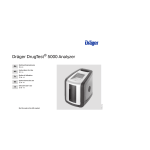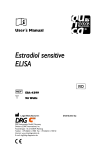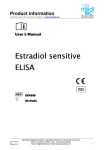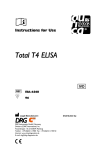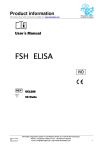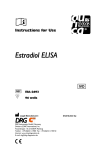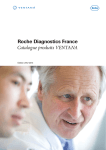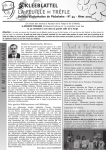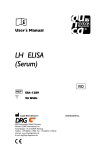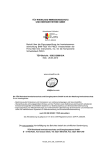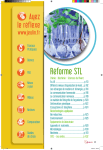Download Salivary Estradiol ELISA
Transcript
Instructions for Use Salivary Estradiol ELISA SLV-4188 96 Legal Manufacturer: DRG Instruments GmbH, Germany Division of DRG International, Inc Frauenbergstr. 18, D-35039 Marburg Telefon: +49 (0)6421-17000 Fax: +49-(0)6421-1700 50 Internet: www.drg-diagnostics.de E-mail: [email protected] Distributed by: DRG Salivary Estradiol ELISA SLV-4188 Contents / Inhaltsverzeichnis 1 2 3 4 5 6 7 8 9 10 11 12 INTRODUCTION ........................................................ 2 PRINCIPLE OF THE TEST ........................................ 2 WARNINGS AND PRECAUTIONS ............................ 2 REAGENTS ................................................................ 3 SPECIMEN COLLECTION AND PREPARATION ...... 5 ASSAY PROCEDURE ................................................ 6 EXPECTED NORMAL VALUES ................................. 7 QUALITY CONTROL.................................................. 7 PERFORMANCE CHARACTERISTICS ..................... 8 LIMITATIONS OF USE ............................................. 11 LEGAL ASPECTS .................................................... 12 REFERENCES / LITERATURE ................................ 12 1 2 3 4 5 6 7 8 9 10 11 12 EINLEITUNG ............................................................ 13 TESTPRINZIP .......................................................... 13 VORSICHTSMAßNAHMEN...................................... 13 BESTANDTEILE DES KITS ..................................... 14 PROBENVORBEREITUNG ...................................... 15 TESTDURCHFÜHRUNG ......................................... 16 ERWARTETE WERTE ............................................. 17 QUALITÄTS-KONTROLLE ....................................... 17 ASSAY CHARACTERISTIKA ................................... 18 GRENZEN DES TESTS ........................................... 18 RECHTLICHE GRUNDLAGEN ................................ 19 REFERENZEN /LITERATUR ................................... 19 1 2 3 4 5 INTRODUCTION ...................................................... 20 PRINCIPE DU TEST ................................................ 20 PRECAUTIONS D’UTILISATION ............................. 20 COMPOSITION DU KIT ........................................... 21 CONSERVATION ET PRÉPARATION DES ÉCHANTILLONS .............................................. 22 RÉALISATION DU TEST ......................................... 23 VALEURS NORMALES ATTENDUES ..................... 24 CONTROLE DE QUALITE ....................................... 24 CARACTERISTIQUES DU TEST ............................. 25 LIMITES D’UTILISATION ......................................... 25 ASPECTS LEGAUX ................................................. 26 REFERENCES / BIBLIOGRAPHIE .......................... 26 6 7 8 9 10 11 12 SYMBOLS USED WITH DRG ELISAS .............................. 27 Vers. 9.0 Effective 2015/04 - vk -1- DRG Salivary Estradiol ELISA SLV-4188 1 INTRODUCTION 1.1 Intended Use Enzyme immunoassay for the in vitro diagnostic quantitative measurement of active free Estradiol, an estrogenic steroid, in saliva. Results may be used in the diagnosis and treatment of various hormonal sexual disorders and in assessing placental function in complicated pregnancy. 1.2 Summary and Explanation Estradiol (1,3,5(10)-estratriene-3,17β-diol; 17β-estradiol; E21) is a C18 steroid hormone with a phenolic A ring. This steroid hormone has a molecular weight of 272.4. It is the most potent natural Estrogen, produced mainly by the Graffian follicle of the female ovary and the placenta, and in smaller amounts by the adrenals, and the male testes (1--3) Estradiol (E2) is secreted into the blood stream where 98% of it circulates bound to sex hormone binding globulin (SHBG) and to a lesser extent to other serum proteins such as albumin. Only a small fraction circulates as free hormone or in the conjugated form (4,5). Estrogenic activity is effected via estradiol-receptor complexes which trigger the appropriate response at the nuclear level in the target sites. These sites include the follicles, uterus, breast, vagine, urethra, hypothalamus, pituitary and to a lesser extent the liver and skin. In non-pregnant women with normal menstrual cycles, estradiol secretion follows a cyclic, biphasic pattern with the highest concentration found immediately prior to ovulation (6,7). The rising estradiol concentration is understood to exert a positive feedback influence at the level of the pituitary where it influences the secretion of the gonadotropins, follicle stimulating hormone (FSH), and luteinizing hormone (LH), which are essential for follicular maturation and ovulation, respectively (8). Following ovulation, estradiol levels fall rapidly until the luteal cells become active resulting in a secondary gentle rise and plateau of estradiol in the luteal phase. During pregnancy, maternal serum Estradiol levels increase considerably, to well above the pre-ovulatory peak levels and high levels are sustained throughout pregnancy (9). 2 PRINCIPLE OF THE TEST The DRG Salivary Estradiol ELISA kit is based on the competition principle and the microplate separation. An unknown amount of Estradiol present in the sample and a fixed amount of Estradiol conjugated with horse-radish peroxidase compete for the binding sites of a polyclonal Estradiol antiserum coated onto the wells. After two hours incubation the microtiter plate is washed to stop the competition reaction. Having added the substrate solution the concentration of Estradiol is inversely proportional to the optical density measured. 3 WARNINGS AND PRECAUTIONS 1. This kit is for in vitro diagnostic use only. For professional use only. 2. All reagents of this test kit which contain human serum or plasma have been tested and confirmed negative for HIV I/II, HBsAg and HCV by FDA approved procedures. All reagents, however, should be treated as potential biohazards in use and for disposal. 3. Before starting the assay, read the instructions completely and carefully. Use the valid version of the package insert provided with the kit. Be sure that everything is understood. 4. The microplate contains snap-off strips. Unused wells must be stored at 2 °C to 8 °C in the sealed foil pouch and used in the frame provided. 5. Pipetting of samples and reagents must be done as quickly as possible and in the same sequence for each step. 6. Use reservoirs only for single reagents. This especially applies to the substrate reservoirs. Using a reservoir for dispensing a substrate solution that had previously been used for the conjugate solution may turn solution colored. Do not pour reagents back into vials as reagent contamination may occur. 7. Mix the contents of the microplate wells thoroughly to ensure good test results. Do not reuse microwells. 8. Do not let wells dry during assay; add reagents immediately after completing the rinsing steps. 9. Allow the reagents to reach room temperature (21 °C to 26 °C) before starting the test. Temperature will affect the absorbance readings of the assay. However, values for the patient samples will not be affected. 10. Never pipet by mouth and avoid contact of reagents and specimens with skin and mucous membranes. 11. Do not smoke, eat, drink or apply cosmetics in areas where specimens or kit reagents are handled. 12. Wear disposable latex gloves when handling specimens and reagents. Microbial contamination of reagents or specimens may give false results. Vers. 9.0 Effective 2015/04 - vk -2- DRG Salivary Estradiol ELISA SLV-4188 13. Handling should be done in accordance with the procedures defined by an appropriate national biohazard safety guideline or regulation. 14. Do not use reagents beyond expiry date as shown on the kit labels. 15. All indicated volumes have to be performed according to the protocol. Optimal test results are only obtained when using calibrated pipettes and microtiterplate readers. 16. Do not mix or use components from kits with different lot numbers. It is advised not to exchange wells of different plates even of the same lot. The kits may have been shipped or stored under different conditions and the binding characteristics of the plates may result slightly different. 17. Avoid contact with Stop Solution containing 0.5 M H2SO4. It may cause skin irritation and burns. 18. Some reagents contain Proclin, BND and MIT as preservatives. In case of contact with eyes or skin, flush immediately with water. 19. TMB substrate has an irritant effect on skin and mucosa. In case of possible contact, wash eyes with an abundant volume of water and skin with soap and abundant water. Wash contaminated objects before reusing them. If inhaled, take the person to open air. 20. Chemicals and prepared or used reagents have to be treated as hazardous waste according to the national biohazard safety guideline or regulation. 21. For information on hazardous substances included in the kit please refer to Safety Data Sheets. Safety Data Sheets for this product are available upon request directly from DRG. 4 REAGENTS 4.1 Reagents provided 1. Microtiterwells, 12x8 (break apart) strips, 96 wells; Wells coated with a anti-Estradiol antibody (polyclonal). 2. Standard (Standard 0-5), 6 vials, 1 mL each, ready to use; Concentration: 0.0; 1, 5, 10, 50, 100 pg/mL Contain non-mercury preservative. 3. Control Low & High, 2 vials, 1.0 mL each, ready to use; Control values and ranges please refer to vial label or QC-Datasheet. Contain non-mercury preservative. 4. Enzyme Conjugate, 1 vial, 26 mL, ready to use; Estradiol conjugated to horseradish peroxidase; Contain non-mercury preservative. 5. Substrate Solution, 1 vial, 25 mL, ready to use; Tetramethylbenzidine (TMB). 6. Stop Solution, 1 vial, 14 mL, ready to use; contains 0.5 M H2SO4. Avoid contact with the stop solution. It may cause skin irritations and burns. 7. Wash Solution, 1 vial, 30 mL; Concentrate for 1200 mL. Note: Additional Standard 0 for sample dilution is available upon request. Vers. 9.0 Effective 2015/04 - vk -3- DRG Salivary Estradiol ELISA SLV-4188 4.2 Material required but not provided Calibrated EIA reader adjusted to read at 450 nm Calibrated variable precision micropipettes (100 µL and 200 µL) Distilled or Deionized water 0.9% NaCl solution Timer (60 min. range) Reservoirs (disposable) Test tube or microtube rack in a microplate configuration Semi-logarithmic graph paper or software for data reduction 4.3 Storage Conditions When stored at 2 °C to 8 °C unopened reagents will retain reactivity until expiration date. Do not use reagents beyond this date. Opened reagents must be stored at 2 °C to 8 °C. Microtiter wells must be stored at 2 °C to 8 °C. Once the foil bag has been opened, care should be taken to close it tightly again. Opened kits retain activity for two months if stored as described above. 4.4 Reagent Preparation Bring all reagents to room temperature before use. Wash Solution Add deionized water to the 40X concentrated Wash Solution. Dilute 30 mL of concentrated Wash Solution with 1170 mL deionized water to a final volume of 1200 mL. The diluted Wash Solution is stable for 2 weeks at room temperature. 4.5 Disposal of the Kit The disposal of the kit must be made according to the national regulations. Special information for this product is given in the Material Safety Data Sheet. 4.6 Damaged Test Kits In case of any severe damage to the test kit or components, DRG has to be informed in writing, at the latest, one week after receiving the kit. Severely damaged single components should not be used for a test run. They have to be stored until a final solution has been found. After this, they should be disposed according to the official regulations. Vers. 9.0 Effective 2015/04 - vk -4- DRG Salivary Estradiol ELISA SLV-4188 5 SPECIMEN COLLECTION AND PREPARATION Eating, drinking, chewing gums or brushing teeth should be avoided for 30 minutes before sampling. Otherwise, it is recommended to rinse mouth thoroughly with cold water 5 minutes prior to sampling. Do not collect samples when oral diseases, inflammation or lesions exist (blood contamination). In case of visible blood contamination the patient should discard the sample, rinse the sampling device with water, wait for 10 minutes and take a new sample. Note: Samples containing sodium azide should not be used in the assay. 5.1 Specimen Collection It is recommended to collect saliva samples with commercially available equipment (e.g. SALI TUBES 100, REF SLV-4158 available from DRG). Do not use any cotton swab for sampling, such as Salivettes; this in most cases will result in significant interferences. Due to the episodic secretion pattern of steroid hormones it is important to care for a proper timing of the sampling. In order to avoid arbitrary results we recommend that always 5 samples be taken within a period of 2 – 3 hours (multiple sampling) preferably before a meal. As food might contain significant amounts of steroid hormones samples preferably should be taken while fasting. If fasting should be a problem the collection period should be timed just before lunch or before dinner. 5.2 Specimen Storage and Preparation Specimens should be capped and may be stored for up to one week at 4 °C prior to assaying. Specimens held for a longer time should be frozen –20 °C prior to assay. Even repeated thawing and freezing is no problem. Each sample has to be frozen, thawed, and centrifuged at least once anyhow in order to separate the mucins by centrifugation. Upon arrival of the samples in the lab the samples have to stay in the deep freeze at least overnight. Next morning the frozen samples are warmed up to room temperature and mixed carefully. Then the samples have to be centrifuged for 5 to 10 minutes (at 3000 - 2000 x g). Now the clear colorless supernatant is easy to pipette. If a set of multiple samples have to be tested, the lab (after at least one freezing, thawing, and centrifugation cycle) has to mix the aliquots of the 5 single samples in a separate sampling device and perform the testing from this mixture. 5.3 Specimen Dilution If in an initial assay, a specimen is found to contain more than the highest standard, the specimens can be diluted with 0.9 % NaCl and re-assayed as described in Assay Procedure. For the calculation of the concentrations this dilution factor has to be taken into account. Example: a) Dilution 1:10: 10 µL saliva + 90 µL 0.9 % NaCl (mix thoroughly) b) Dilution 1:100: 10 µL of dilution a + 90 µL 0.9 % NaCl (mix thoroughly). Vers. 9.0 Effective 2015/04 - vk -5- DRG Salivary Estradiol ELISA SLV-4188 6 6.1 ASSAY PROCEDURE General Remarks All reagents and specimens must be allowed to come to room temperature before use. All reagents must be mixed without foaming. Once the test has been started, all steps should be completed without interruption. Use new disposal plastic pipette tips for each standard, control or sample in order to avoid cross contamination. Absorbance is a function of the incubation time and temperature. Before starting the assay, it is recommended that all reagents are ready, caps removed, all needed wells secured in holder, etc. This will ensure equal elapsed time for each pipetting step without interruption. As a general rule the enzymatic reaction is linearly proportional to time and temperature. 6.2 Test Procedure Each run must include a standard curve. All standards, samples, and controls should be run in duplicate. All standards, samples, and controls should be run concurrently so that all conditions of testing are the same. 1. 2. 3. 4. Secure the desired number of Microtiter wells in the holder. Dispense 100 µL of each Standard, Control and samples with new disposable tips into appropriate wells. Incubate for 30 minutes at room temperature Dispense 200 µL of Enzyme Conjugate into each sample and standard well Mix the plate thoroughly for 10 seconds. It is important to have a complete mixing in this step. 5. Incubate for 120 minutes at room temperature. 6. Briskly shake out the contents of the wells. Rinse the wells 3 times with diluted Wash Solution (400 µL per well). Strike the wells sharply on absorbent paper to remove residual droplets. Important note: The sensitivity and precision of this assay is markedly influenced by the correct performance of the washing procedure! 7. Add 200 µL of Substrate Solution to each well. 8. Incubate for 30 minutes at room temperature. 9. Stop the enzymatic reaction by adding 100 µL of Stop Solution to each well. 10. Determine the absorbance (OD) of each well at 450±10 nm with a microtiter plate reader. It is recommended that the wells be read within 10 minutes after adding the Stop Solution. 6.3 Calculation of Results 1. Calculate the average absorbance values for each set of standards, controls and patient samples. 2. Using semi-logarithmic graph paper, construct a standard curve by plotting the mean absorbance obtained from each standard against its concentration with absorbance value on the vertical (Y) axis and concentration on the horizontal (X) axis. 3. Using the mean absorbance value for each sample, determine the corresponding concentration from the standard curve. 4. Automated method: The results in the IFU have been calculated automatically using a 4 PL (4 Parameter Logistics) curve fit. 4 Parameter Logistics is the preferred method. Other data reduction functions may give slightly different results. 5. The concentration of the samples can be read directly from this standard curve. Samples with concentrations higher than that of the highest standard have to be further diluted or reported as > 100 pg/mL. For the calculation of the concentrations this dilution factor has to be taken into account. Vers. 9.0 Effective 2015/04 - vk -6- DRG Salivary Estradiol ELISA SLV-4188 6.3.1 Example of Typical Standard Curve The following data is for demonstration only and cannot be used in place of data generations at the time of assay. Standard Absorbance Units Standard 0 (0 pg/mL) Standard 1 (1 pg/mL) Standard 2 (5 pg/mL) Standard 3 (10 pg/mL) Standard 4 (50 pg/mL) Standard 5 (100 pg/mL) 2.08 1.90 1.62 1.40 0.58 0.21 7 EXPECTED NORMAL VALUES In order to determine the normal range of SLV Estradiol, saliva samples from152 adult male and 186 female apparently healthy subjects, ages 21 to 75 years, were collected in the morning and analyzed using the DRG SLV Estradiol ELISA kit. The following ranges were calculated from this study. Age group Women 21 - 50 yrs. Men 51 - 75 yrs. 21 - 30 yrs 31 - 40 yrs 41 - 50 yrs 51 - 60 yrs 61 - 75 yrs Salivary Estradiol [pg/mL] Follicular phase: n = 48 Mid cycle: n = 40 Luteal phase: n = 58 Postmenopausal: n = 40 n = 24 n = 36 n = 28 n = 32 n = 32 1.29 – 7.76 3.79 – 16.05 1.22 - 8.43 0.56 – 4.39 2.71 – 4.75 1.01 – 4.15 1.00 - 4.63 0.88 – 4.09 1.33 – 4.39 Therapy should not be decided based on results alone. The results should be correlated to other clinical observations and diagnostic tests. Salivary Estradiol values show a clear circadian rhythm. We therefore recommend the saliva samples be obtained the same hour each day. Furthermore, we recommend that each laboratory establish its own range for the population tested, because the values differ between age, new born, children, adolescents and adults. 8 QUALITY CONTROL Good laboratory practice requires that controls be run with each calibration curve. A statistically significant number of controls should be assayed to establish mean values and acceptable ranges to assure proper performance. It is recommended to use control samples according to state and federal regulations. The use of control samples is advised to assure the day to day validity of results. Use controls at both normal and pathological levels. The controls and the corresponding results of the QC-Laboratory are stated in the QC certificate added to the kit. The values and ranges stated on the QC sheet always refer to the current kit lot and should be used for direct comparison of the results. It is also recommended to make use of national or international Quality Assessment programs in order to ensure the accuracy of the results. Employ appropriate statistical methods for analysing control values and trends. If the results of the assay do not fit to the established acceptable ranges of control materials patient results should be considered invalid. In this case, please check the following technical areas: Pipetting and timing devices; photometer, expiration dates of reagents, storage and incubation conditions, aspiration and washing methods. After checking the above mentioned items without finding any error contact your distributor or DRG directly. Vers. 9.0 Effective 2015/04 - vk -7- DRG Salivary Estradiol ELISA SLV-4188 9 PERFORMANCE CHARACTERISTICS 9.1 Assay Dynamic Range The range of the assay is between 0.8 – 93 pg/mL. 9.2 Specificity The following materials have been evaluated for cross reactivity. The percentage indicates cross reactivity at 50% displacement compared to Estradiol. Steroid Cross reaction [%] Estradiol Estron Estriol Androstenedione Androsterone Corticosterone Epiandrosterone 16-Epiestriol Estadiol-3-sulfate Estradiol-3-glucoronide Estradiol-17α Estriol-16-glucoronide Estrone-3-sulfate Dehydroepiandrosterone 11-Desoxycortisol 11-Desoxycorticosterone 21-Desoxycortisol Dihydrotestosterone Dihydroepiandrosterone 20-Dihydroprogesterone 11-Hydroxyprogesterone 17 alpha-Hydroxyprogesterone 17 alpha-Pregnenolone 17 alpha Progesterone Pregnanediol Pregnantriol Pregnenolone Progesterone Testosterone 100 0.20 0.05 0.00 0.00 0.00 0.00 0.00 0.00 0.00 0.00 0.00 0.00 0.00 0.00 0.00 0.00 0.00 0.00 0.00 0.00 0,00 0,00 0.00 0.00 0.00 0.00 0.00 0.00 9.3 Sensitivity The lowest detectable level of Estradiol that can be distinguished from the Zero Standard is 0.4 pg/mL at the 95 % confidence limit. Vers. 9.0 Effective 2015/04 - vk -8- DRG Salivary Estradiol ELISA SLV-4188 9.4 Reproducibility 9.4.1 Intra Assay The intra-assay variation was determined by 20 replicate measurements of 4 saliva samples using DRG ELISA kit. The within assay variability is shown below: Sample 3 Sample 2 Sample 1 Sample 4 Mean (pg/mL) 4.6 9.6 53.5 77.2 SD (pg/mL) CV (%) n= 0.3 6.4 20 0.7 6.9 20 1.8 3.4 20 2.0 2.6 20 9.4.2 Inter Assay The inter-assay (between-run) variation was determined by duplicate measurements of five saliva samples over 10 different days runs. The between assay variability is shown below: Mean (pg/mL) SD (pg/mL) CV (%) n= Sample 4 Sample 1 Sample 5 Sample 2 Sample 3 2.1 0.1 3.8 20 3.9 0.1 3.6 20 5.1 0.1 2.1 20 10.1 0.3 3.3 20 20.8 0.9 4.3 20 9.4.3 Inter-Lot The Inter-Lot (between-lot) variation was determined by triplicate measurements of five saliva samples in three different kit lots. The between lot variability is shown below: Mean (pg/mL) SD (pg/mL) CV (%) n= Vers. 9.0 Sample 3 1.9 0.2 9.5 9 Effective 2015/04 - vk Sample 1 2.7 0.2 7.1 9 Sample 5 4.4 0.1 3.2 9 -9- Sample 4 5.6 0.2 4.1 9 Sample 2 12.1 0.4 3.4 9 DRG Salivary Estradiol ELISA SLV-4188 9.5 Recovery Recovery of the DRG ELISA was determined by adding increasing amounts of the analyte to three different saliva samples containing different amounts of endogenous analyte. Each sample (non-spiked and spiked) was assayed and analyte concentrations of the samples were calculated from the standard curve. The percentage recoveries were determined by comparing expected and measured values of the samples. Measured OD Endogenous Added Measured Conc. Expected Conc. Sample Estradiol Estradiol Mean of duplicate pg/mL pg/mL 450 nm pg/mL pg/mL 1 2 3 2.0 3.4 6.5 0 50 25 5 2.5 0 50 25 5 2.5 0 50 25 5 2.5 1.953 0.490 0.814 1.600 1.758 1.846 0.476 0.809 1.544 1.695 1.630 0.453 0.775 1.321 1.497 2.0 50.0 28 7.0 4.6 3.4 51.6 28.2 7.9 5.5 6.5 54.1 29.9 12.1 8.7 Recovery (%) 52.0 27.0 7.0 4.5 96.3 103.7 100.0 102.5 53.4 28.4 8.4 5.9 96.6 99.3 94.2 93.7 56.5 31.5 11.5 9.0 95.8 94.7 105.5 96.8 9.6 Linearity Four samples (saliva) containing different amounts of analyte were serially diluted up to 1:128 with 0.9% NaCl and assayed with the DRG ELISA. The percentage recovery was calculated by comparing the expected and measured values for SLV estradiol. An assay linearity of 0.8 – 93 pg/mL has been identified as the usable range. Samples above this range must be diluted and re-run. Concentration (pg/mL) Average % recovery Range of from Recovery % to Vers. 9.0 Sample 4 8.5 107.7 102.8 113.6 Effective 2015/04 - vk Sample 3 26.6 103.8 94.6 108.7 - 10 - Sample 2 95.0 97.0 91.3 102.8 Sample 1 400.0 99.1 93.1 106.9 DRG Salivary Estradiol ELISA SLV-4188 9.7 Comparison Studies A study was performed to compare the DRG Salivary Estradiol test to a commercially available test using saliva samples from 230 men and women 20 to 70 years. The samples were run in duplicate on the DRG test and another commercially available LIA method to determine the concentration of Estradiol in the samples. A correlation of r = 0.9951 was obtained versus this method with a regression formula shown below. DRG Estradiol correlation 25 y = 0.8512x + 0.0774 DRG ELISA 20 15 10 5 0 0 5 10 15 20 25 LIA 10 LIMITATIONS OF USE Reliable and reproducible results will be obtained when the assay procedure is performed with a complete understanding of the package insert instruction and with adherence to good laboratory practice. Any improper handling of samples or modification of this test might influence the results. The patient should not eat, drink, chew gum or brush teeth for 30 minutes before sampling. Otherwise rinse mouth thoroughly with cold water 5 min prior to sample collection. Do not collect samples when oral diseases, inflammation or lesions exist (blood contamination). 10.1 Interfering Substances Blood contamination of more than 0.16% in saliva samples will affect results, and usually can be seen by eye. Therefore, samples containing any visible blood should not be used. Concentrations of Sodium Azide ≥ 0.02% interferes in this assay and may lead to false results. 10.2 High-Dose-Hook Effect No hook effect was observed in this test. Vers. 9.0 Effective 2015/04 - vk - 11 - DRG Salivary Estradiol ELISA SLV-4188 11 LEGAL ASPECTS Only for countries where the declaration of European Conformity (CE mark) is applicable. 11.1 Reliability of Results The test must be performed exactly as per the manufacturer’s instructions for use. Moreover the user must strictly adhere to the rules of GLP (Good Laboratory Practice) or other applicable national standards and/or laws. This is especially relevant for the use of control reagents. It is important to always include, within the test procedure, a sufficient number of controls for validating the accuracy and precision of the test. The test results are valid only if all controls are within the specified ranges and if all other test parameters are also within the given assay specifications. In case of any doubt or concern please contact DRG. 11.2 Therapeutic Consequences Therapeutic consequences should never be based on laboratory results alone even if all test results are in agreement with the items as stated under point 11.1. Any laboratory result is only a part of the total clinical picture of a patient. Only in cases where the laboratory results are in acceptable agreement with the overall clinical picture of the patient should therapeutic consequences be derived. The test result itself should never be the sole determinant for deriving any therapeutic consequences. 11.3 Liability Any modification of the test kit and/or exchange or mixture of any components of different lots from one test kit to another could negatively affect the intended results and validity of the overall test. Such modification and/or exchanges invalidate any claim for replacement. Claims submitted due to customer misinterpretation of laboratory results subject to point 11.2. are also invalid. Regardless, in the event of any claim, the manufacturer’s liability is not to exceed the value of the test kit. Any damage caused to the test kit during transportation is not subject to the liability of the manufacturer. 12 REFERENCES / LITERATURE 1. Tsang B.K., et al. (1980) Steroid biosyntheses by isolated human ovarian follicular cells in vitro, J. Clin. Endocrinol. Metab. 51, 1407 – 11 2. Gore-Langton R. E. et al. (1988): Follicular steroidogenesis and its control. In: The physiology of Reproduction. ED.: Knobil et al. pp.331-385, Raven press, New York 3. Hall, P.F. (1988): Steroid synthesis: Organization and Regulation. In: The Physiology of Reproduction. Ed.: Knobil et al., pp 975 – 988, Raven press, New York 4. Siiteri P.K. et al. (1982): The serum transport of steroid hormones. Rec. Progr. Horm. Res. 38, 457 – 510 5. Martin B. et al. (1981): Binding of steroids by proteins in follicular fluid of the human ovary. J. Clin. Endocrinol. Metab. 35, 443 – 447 6. Baird D.T. (1976): Ovarian steroid secretion and metabolism in women. In: The Endocrine function of the human ovary. Eds.: James V.H.T., Serio M. and Guisti G., pp. 125 – 33, Academic press, New York 7. McNtty K.P. et al. (1976): Concentration of estrogens and androgens in human ovarian venous plasma and follicular fluid throughout the menstrual cycle. J. Endocrinol. 71, 77 –85 8. March C.M. et al. (1979): Roles of estradiol and progesterone in eliciting mid-cycle luteinizing hormone and follicle stimulating hormone surges. J. Clin. Endocrinol. Metab. 49, 507 – 12 9. Simpson E.R. and McDonald P.C. (1981): Endocrinology of pregnancy. In: Textbook of Endocrinology, Ed.: Williams R.H. pp. 412 – 22, Saunders Company, Philadelphia Vers. 9.0 Effective 2015/04 - vk - 12 - DRG Salivary Estradiol ELISA SLV-4188 1 EINLEITUNG Der DRG Salivary Estradiol ELISA wird zur quantitativen Bestimmung von Estradiol in Speichel eingesetzt. Nur für In-vitro Diagnostik. 2 TESTPRINZIP Der DRG Salivary Estradiol ELISA ist ein Festphasen-Enzymimmunoassay, der auf dem Prinzip der kompetitiven Bindung basiert. Die Wells der Mikrotiterplatten sind mit einem polyklonalen Antikörper beschichtet, der gegen eine AntikörperBindungsstelle des Estradiol-Moleküls gerichtet ist. Die Proben werden in die beschichteten Wells gegeben und zusammen mit einem Estradiol-Enzymkonjugat inkubiert. Während der Inkubation konkurriert das Estradiol aus der Probe mit dem Estradiol-Enzymkonjugat um die freien Bindungsstellen auf den beschichteten Wells. Das nicht gebundene Konjugat wird durch Waschen der Wells entfernt. Anschließend wird die Substratlösung zugegeben und die Farbentwicklung nach einer definierten Zeit gestoppt. Die Intensität der gebildeten Farbe ist umgekehrt proportional der Estradiol-Konzentration in der Probe. Die Extinktion wird bei 450 nm mit einem Mikrotiterplattenleser gemessen. 3 VORSICHTSMAßNAHMEN Dieser Kit ist nur zum in vitro diagnostischen Gebrauch geeignet. Informationen zu im Kit enthaltenen gefährlichen Substanzen entnehmen Sie bitte dem Materialsicherheitsdatenblatt. Alle Bestandteile dieses Testkits, die humanes Serum oder Plasma enthalten, wurden mit FDA-geprüften Methoden auf HIV I/II, HbsAg und HCV getestet und als negativ bestätigt. Jedoch sollten alle Bestandteile im Umgang und bei der Entsorgung wie mögliche Gefahrenstoffe betrachtet werden. Der Kontakt mit der Stop Solution sollte vermieden werden, da sie 0.5 M H2SO4 enthält. Schwefelsäure kann Hautreizungen und Verbrennungen verursachen. Nicht mit dem Mund pipettieren und den Kontakt von Kitbestandteilen und Proben mit Haut und Schleimhäuten vermeiden. In den Bereichen, in denen Proben oder Kitbestandteile verwendet werden, nicht rauchen, essen oder Kosmetika verwenden. Beim Umgang mit Proben oder Reagenzien Einweg-Latexhandschuhe tragen. Die Verunreinigung von Reagenzien oder Proben mit Mikroben kann zu falschen Ergebnissen führen. Der Gebrauch sollte gemäß der Vorschriften einer entsprechenden nationalen Gefahrenstoff-Sicherheitsrichtlinie erfolgen. Reagenzien nicht nach dem auf dem Kit-Etikett angegebenen Verfallsdatum verwenden. Alle im Kit-Protokoll angegebenen Mengen müssen genau eingehalten werden. Optimale Ergebnisse können nur durch Verwendung kalibrierter Pipetten und Mikrotiterplatten-Lesegeräte erreicht werden. Komponenten von Kits mit unterschiedlichen Lotnummern nicht untereinander vertauschen. Es wird empfohlen, keine Wells von verschiedenen Platten zu verwenden, auch nicht, wenn es sich um das gleiche Lot handelt. Die Kits können unter anderen Bedingungen gelagert oder versendet worden sein, so dass die Bindungscharakteristik der Platten leicht unterschiedlich ausfällt. Chemikalien und zubereitete oder bereits benutzte Reagenzien müssen gemäß den nationalen Gefahrenstoffvorschriften wie gefährlicher Abfall behandelt werden. Sicherheitsdatenblätter für dieses Produkt sind auf Anfrage direkt von der Firma DRG Instruments GmbH erhältlich. Vers. 9.0 Effective 2015/04 - vk - 13 - DRG Salivary Estradiol ELISA SLV-4188 4 BESTANDTEILE DES KITS 4.1 Kitinhalt 1. Microtiterwells, 96 Wells, 12x8 Wells (einzeln brechbar); mit anti-Estradiol-Antikörper (polyklonal) beschichtet. 2. Standard (Standard 0-5), 6 Fläschchen, je 1 mL, gebrauchsfertig; Konzentrationen: 0.0; 1, 5, 10, 50, 100 pg/mL Enthält quecksilberfreies Konservierungsmittel. 3. Control Low & High (Kontrollen), 2 Fläschchen, je 1,0 mL; gebrauchsfertig Enthält quecksilberfreies Konservierungsmittel. Kontrollwerte und –bereiche entnehmen Sie bitte dem Fläschchenetikett oder dem QC-Datenblatt. 4. Enzyme Conjugate (Enzymkonjugat), 1 Fläschchen, 26 mL, gebrauchsfertig; Estradiol mit Meerrettichperoxidase konjugiert. Enthält quecksilberfreies Konservierungsmittel. 5. Substrate Solution (Substratlösung), 1 Fläschchen, 25 mL, gebrauchsfertig; Substratlösung TMB. 6. Stop Solution (Stopplösung), 1 Fläschchen, 14 mL, gebrauchsfertig; Enthält 0,5 M H2SO4. Kontakt mit der Stopplösung vermeiden! Kann Hautreizungen und Verbrennungen verursachen. 7. Wash Solution (Waschlösung), 40X konzentriert, 1 Fläschchen, 30 mL; Siehe „Vorbereitung der Reagenzien“. Anmerkung: Zusätzlicher Standard 0 zur Probenverdünnung ist auf Anfrage erhältlich. 4.2 Nicht im Kit enthaltene aber erforderliche Geräte und Materialien Kalibriertes Mikrotiterplattenlesegerät mit 450 ± 10 nm Filter), (z.B. das DRG Instruments Mikrotiterplattenlesegerät) Kalibrierte variable Präzisions-Mikropipette (100 µL, 200 µL) Saugfähiges Papier Aqua dest. 0,9% NaCl-Lösung 4.3 Lagerung und Haltbarkeit des Kits Die ungeöffneten Reagenzien behalten bei Lagerung um 2°C - 8°C ihre Reaktivität bis zum Verfallsdatum. Nach dem Verfallsdatum die Reagenzien nicht mehr verwenden. Nach dem Öffnen sollten alle Reagenzien bei 2°C - 8°C gelagert werden. Die Mikrotiterwells sollten bei 2°C - 8°C gelagert werden. Der einmal geöffnete Folienbeutel sollte stets sehr sorgfältig wieder verschlossen werden. Unter den beschriebenen Lagerbedingungen behalten geöffnete Kits zwei Monate ihre Reaktivität. 4.4 Vorbereitung der Reagenzien Alle Reagenzien sowie die benötigte Anzahl von Wells sollen vor dem Gebrauch auf Raumtemperatur gebracht werden. Wash Solution Die 40-fach konzentrierte Waschlösung (30 mL) mit 1170 mL destilliertem Wasser auf ein Gesamtvolumen von 1200 mL verdünnen. Die verdünnte Waschlösung ist bei Raumtemperatur für 2 Wochen stabil. 4.5 Entsorgung des Kits Die Entsorgung des Kits muss gemäß den nationalen gesetzlichen Vorschriften erfolgen. Spezielle Informationen für dieses Produkt finden Sie im Materialsicherheitsdatenblatt, Kapitel 13. 4.6 Beschädigte Testkits Im Falle einer starken Beschädigung des Testkits oder der Komponenten muss die Firma DRG in schriftlicher Form spätestens eine Woche nach Erhalt des Kits informiert werden. Stark beschädigte Einzelkomponenten sollten nicht für den Testlauf verwendet werden. Sie müssen gelagert werden bis eine endgültige Lösung gefunden wurde. Danach sollten Sie gemäß den offiziellen Richtlinien entsorgt werden. Vers. 9.0 Effective 2015/04 - vk - 14 - DRG Salivary Estradiol ELISA SLV-4188 5 PROBENVORBEREITUNG Speichelproben werden in diesem Test als Probenmaterial eingesetzt. Der Patient sollte vor der Probenahme 30 Minuten nicht essen, trinken, Kaugummi kauen oder Zähne putzen. Andernfalls 5 Minuten vor der Probenahme den Mund gründlich mit kaltem Wasser spülen. Speichelproben sollten nicht bei Krankheiten, Entzündungen oder Verletzungen der Mundhöhle entnommen werden (Blutkontamination). Im Falle einer sichtbaren Kontamination mit Blut sollte die Probe verworfen werden. Das Probenbesteck wird mit Wasser gewaschen und nach 10 Minuten kann eine neue Probe genommen werden. Achtung: Proben, die Natriumazid enthalten, sollten nicht verwendet werden. 5.1 Probenentnahme Wir empfehlen Speichelproben mit einem kommerziell verfügbaren Besteck zu sammeln (z.B. SALI TUBES 100, REF SLV-4158 erhältlich bei DRG). Es sollte kein Besteck mit Baumwolltupfer verwendet werden, wie z.B. Salivetten, da dies in den meisten Fällen zu deutlichen Interferenzen führt. Da die Steroidhormone ein deutliches episodisches Sekretionsmuster zeigen, ist es wichtig auf den richtigen Zeitpunkt der Probenentnahme zu achten. Um arbiträre (willkürliche) Ergebnisse zu vermeiden, empfehlen wir 5 Proben in einem Zeitraum von 2 bis 3 Stunden zu sammeln (mehrfache Probeentnahme). Dies sollte vorzugsweise vor einer Mahlzeit durchgeführt werden. Da Lebensmittel eine bedeutende Menge an Steroidhormonen enthalten können, sollten die Proben möglichst nüchtern entnommen werden. Ist dies nicht möglich, sollte die Sammelperiode auf jeden Fall vor einer Mahlzeit liegen. 5.2 Probenaufbewahrung Proben sollten stets gut verschlossen sein und können vor Testbeginn bis zu einer Woche bei 2°C - 8°C gelagert werden. Für eine längere Aufbewahrung sollten die Proben eingefroren bei –20°C bis zum Testbeginn gelagert werden. Mehrfaches Auftauen und erneutes Einfrieren ist möglich. Um Muzine aus der Probe zu entfernen, muss jede Probe mindestens einmal eingefroren und aufgetaut und anschließend zentrifugiert werden. Nach der Ankunft im Labor muss eine Probe mindestens über Nacht tiefgekühlt gelagert werden. Am nächsten Morgen wird die eingefrorene Probe auf Raumtemperatur gebracht und vorsichtig gemischt. Dann muss die Probe 5 bis 10 Minuten zentrifugiert werden (bei 3000 – 2000 x g). Der klare, farblose Überstand kann jetzt einfach pipettiert werden. Wird ein solches Set an Mehrfach-Proben getestet (nach mindestens einem Einfrier- Auftau- und Zentrifugationszyklus) muss im Labor in einem separaten Probengefäß eine Mischprobe aus Aliquots aller 5 Einzelproben hergestellt werden. Diese Mischprobe wird im Test eingesetzt. 5.3 Probenverdünnung Wenn in einem ersten Testdurchlauf bei einer Probe eine Konzentration höher als der höchste Standard gefunden wird, kann diese Probe mit 0,9 % NaCl weiter verdünnt und nochmals bestimmt werden. Die Verdünnung muss jedoch bei der Berechnung der Konzentration beachtet werden. Beispiel: a) Verdünnung 1:10: 10 µL Speichelprobe + 90 µL 0,9% NaCl gründlich mischen) b) Verdünnung 1:100: 10 µL Verdünnung a) 1:10 + 90 µL 0,9% NaCl (gründlich mischen). Vers. 9.0 Effective 2015/04 - vk - 15 - DRG Salivary Estradiol ELISA SLV-4188 6 TESTDURCHFÜHRUNG 6.1 Allgemeine Hinweise Alle Reagenzien und Proben müssen vor Gebrauch auf Raumtemperatur gebracht und gut durchgemischt werden. Dabei sollte Schaumbildung vermieden werden. Wenn die Testdurchführung einmal begonnen wurde, muss sie ohne Unterbrechung zu Ende geführt werden. Für jeden Standard, jede Kontrolle oder Probe eine neue Plastikspitze verwenden, um Verschleppungen zu vermeiden. Die Optische Dichte ist abhängig von Inkubationszeit und Temperatur. Deshalb ist es notwendig, vor Beginn der Testdurchführung alle Reagenzien in einen arbeitsbereiten Zustand zu bringen, die Deckel der Fläschchen zu öffnen, alle benötigten Wells in den Halter zu setzen. Nur eine solche Vorbereitung garantiert gleiche Zeiten für jeden Pipettiervorgang ohne Pausen. Als generelle Regel gilt, dass die enzymatische Reaktion linear proportional zu Zeit und Temperatur ist. 6.2 Testdurchführung Jeder Lauf muss eine Standardkurve beinhalten. 1. 2. 3. 4. 5. 6. Die benötigte Anzahl Wells in der Halterung befestigen. Je 100 µL Standards, Controls und Proben mit neuen Plastikspitzen in die entsprechenden Wells geben. 30 Minuten bei Raumtemperatur inkubieren. 200 µL Enzyme Conjugate in jedes Well geben. 120 Minuten bei Raumtemperatur inkubieren. Den Inhalt der Wells kräftig ausschütteln. Wells 3mal mit verdünnter Waschlösung waschen. Verbleibende Flüssigkeit durch Ausklopfen der Wells auf saugfähigem Papier entfernen. Achtung: Die Sensitivität und Präzision dieses Assays wird erheblich beeinflusst von der korrekten Durchführung des Waschschrittes! 7. 200 µL Substrate Solution in jedes Well geben. 8. 30 Minuten bei Raumtemperatur inkubieren. 9. Die enzymatische Reaktion durch Zugabe von 100 µL Stop Solution in jedes Well abstoppen. 10. Die Optische Dichte bei 450±10 nm mit einem Mikrotiterplatten-Lesegerät innerhalb von 10 Minuten nach Zugabe der Stop Solution bestimmen. 6.3 Ergebnisermittlung 1. Die durchschnittlichen Werte der Optischen Dichte (OD) für jedes Set von Standards, Controls und Patientenproben bestimmen. 2. Eine Standardkurve ermitteln durch Auftragen der mittleren Optischen Dichte jedes Standards gegen die Konzentration, wobei der OD-Wert auf der vertikalen (Y) Achse und die Konzentration auf der horizontalen (X) Achse eingetragen wird. 3. Unter Verwendung der mittleren OD wird für jede Probe die entsprechende Konzentration aus der Standardkurve ermittelt. 4. Automatische Methode: Die in der Arbeitsanleitung ermittelten Werte wurden automatisch mit Hilfe der 4 Parameter Gleichung (4PL, 4 Parameter Logistics, 4 Parameter Rodbard) bestimmt. Andere Auswertungsfunktionen können leicht abweichende Werte ergeben. 5. Die Konzentration der Proben kann direkt von der Standardkurve abgelesen werden. Proben, die eine höhere Konzentration als die des höchsten Standards enthalten, müssen verdünnt werden. Dieser Verdünnungsfaktor muss bei der Berechnung der Konzentration beachtet werden. Vers. 9.0 Effective 2015/04 - vk - 16 - DRG Salivary Estradiol ELISA SLV-4188 6.3.1 Beispiel für eine Standardkurve Nachfolgend wird ein typisches Beispiel für eine Standardkurve mit dem DRG ELISA gezeigt. Diese Werte sollten nicht zur Berechnung von Patientendaten verwendet werden. Standard Optische Dichte (450nm) Standard 0 (0 pg/mL) 2,08 Standard 1 Standard 2 Standard 3 Standard 4 Standard 5 1,90 1,62 1,40 0,58 0,21 (1 pg/mL) (5 pg/mL) (10 pg/mL) (50 pg/mL) (100 pg/mL) 7 ERWARTETE WERTE Es wird empfohlen, dass jedes Labor seine eigenen normalen und abnormalen Werte ermittelt. Zur Ermittlung der Normwerte wurden Speichelproben von 152 erwachsenen Männer und 186 Frauen (scheinbar gesunden Individuen) im Alter von 21 bis 75 Jahren untersucht. Die Proben wurden morgens gesammelt und mit dem DRG Salivary Estradiol ELISA gemessen. In der Studie ergaben sich folgende Werte. Alter (Jahre) Frauen 21 - 50 Männer 51 - 75 21 - 30 31 - 40 41 - 50 51 - 60 61 - 75 Salivary Estradiol [pg/mL] Follikularphase: n = 48 Zyklusmitte: n = 40 Lutealphase: n = 58 Postmenopausal: n = 40 n = 24 n = 36 n = 28 n = 32 n = 32 1,29 – 7,76 3,79 – 16,05 1,22 - 8,43 0,56 – 4,39 2,71 – 4,75 1,01 – 4,15 1,00 - 4,63 0,88 – 4,09 1,33 – 4,39 Estradiol-Werte im Speichel zeigen einen klaren zirkadianen Rhythmus. Aus diesem Grund sollten Proben immer zur selben Zeit gewonnen werden. Jedes Labor sollte seinen eigenen Normbereich ermitteln, da die Werte altersabhängig sind und sich unterscheiden bei Neugeborenen, Kindern, Jugendlichen und Erwachsenen. 8 QUALITÄTS-KONTROLLE Es wird empfohlen, die Kontrollproben gemäß den nationalen gesetzlichen Bestimmungen einzusetzen. Durch die Verwendung von Kontrollproben wird eine Tag-zu-Tag Überprüfung der Ergebnisse erzielt. Es sollten Kontrollen sowohl mit normalem als auch pathologischem Level eingesetzt werden. Die Kontrollen mit den entsprechenden Ergebnissen des QC-Labors sind im QC-Zertifikat, das dem Kit beiliegt, aufgeführt. Die im QC-Blatt angegebenen Werte und Bereiche beziehen sich stets auf die aktuelle Kitcharge und sollten zum direkten Vergleich der Ergebnisse verwendet werden. Es wird ebenfalls empfohlen, an nationalen oder internationalen Qualitätssicherungs-Programmen teilzunehmen, um die Genauigkeit der Ergebnisse zu sichern. Es sollten geeignete statistische Methoden zur Analyse von Kontroll-Werten und Trends angewendet werden. Wenn die Ergebnisse des Assays nicht mit den angegebenen Akzeptanzbereichen des Kontrollmaterials übereinstimmen, sollten die Patientenergebnisse als ungültig eingestuft werden. In diesem Fall überprüfen Sie bitte die folgenden Bereiche: Pipetten und Zeitnehmer, Photometer, Verfallsdatum der Reagenzien, Lagerungs- und Inkubationsbedingungen, Absaug- und Waschmethode. Sollten Sie nach Überprüfung der vorgenannten Bereiche keinen Fehler erkannt haben, setzen Sie sich bitte mit Ihrem Lieferanten oder direkt mit der Firma DRG in Verbindung. Vers. 9.0 Effective 2015/04 - vk - 17 - DRG Salivary Estradiol ELISA SLV-4188 9 ASSAY CHARACTERISTIKA 9.1 Messbereich Der Messbereich des Testes liegt zwischen 0.8 – 93 pg/mL. 9.2 Spezifität der Antikörper (Kreuzreaktivität) Die Daten entnehmen Sie bitte der ausführlichen englischen Arbeitsanleitung. 9.3 Sensitivität Die analytische Sensitivität, definiert als Mittelwert minus der zweifachen Standardabweichung des Standards 0 (n = 20), beträgt 0,4 pg/mL. Die Daten zu: 9.4 Präzision 9.5 Wiederfindung 9.6 Linearität entnehmen Sie bitte der ausführlichen englischen Arbeitsanleitung. 10 GRENZEN DES TESTS Jede unsachgemäße Behandlung von Proben oder Modifikationen dieses Tests können die Ergebnisse beeinflussen. 10.1 Interferenzen Eine Kontamination der Speichelproben mit Blut von mehr als 0,16 % beeinflusst das Ergebnis. Eine solche Verunreinigung kann bereits mit den Augen wahrgenommen werden. Konzentrationen von Natriumazid ≥ 0,02 % beeinflussen den Test und können zu falschen Ergebnissen führen. 10.2 Beeinflussung durch Medikamente Uns sind bislang keine Stoffe (Medikamente) bekannt geworden, deren Einnahme die Messung des Estradiol-Gehaltes der Probe beeinflussen würde. 10.3 High-Dose-Hook Effekt Ein Hook Effekt tritt in diesem Test nicht auf. Vers. 9.0 Effective 2015/04 - vk - 18 - DRG Salivary Estradiol ELISA SLV-4188 11 RECHTLICHE GRUNDLAGEN 11.1 Zuverlässigkeit der Ergebnisse Der Test muss exakt gemäß der Testanleitung des Herstellers abgearbeitet werden. Darüber hinaus muss der Benutzer sich strikt an die Regeln der GLP (Good Laboratory Practice) oder andere eventuell anzuwendende Regeln oder nationale gesetzliche Vorgaben halten. Dies betrifft besonders den Gebrauch der Kontrollreagenzien. Es ist sehr wichtig, bei der Testdurchführung stets eine ausreichende Anzahl Kontrollen zur Überprüfung der Genauigkeit und Präzision mitlaufen zu lassen. Die Testergebnisse sind nur gültig, wenn alle Kontrollen in den vorgegebenen Bereichen liegen, und wenn alle anderen Testparameter die vorgegebenen Spezifikationen für diesen Assay erfüllen. Wenn Sie bezüglich eines Ergebnisses Zweifel oder Bedenken haben, setzen Sie sich bitte mit der Firma DRG in Verbindung. 11.2 Therapeutische Konsequenzen Therapeutische Konsequenzen sollten keinesfalls nur aufgrund von Laborergebnissen erfolgen, selbst dann nicht, wenn alle Testergebnisse mit den in 11.1. genannten Voraussetzungen übereinstimmen. Jedes Laborergebnis ist nur ein Teil des klinischen Gesamtbildes eines Patienten. Nur in Fällen, in denen die Laborergebnisse in akzeptabler Übereinstimmung mit dem allgemeinen klinischen Bild des Patienten stehen, sollten therapeutische Konsequenzen eingeleitet werden. Das Testergebnis allein sollte niemals als alleinige Grundlage für die Einleitung therapeutischer Konsequenzen dienen. 11.3 Haftung Jegliche Veränderungen des Testkits und/oder Austausch oder Vermischung von Komponenten unterschiedlicher Chargen von einem Testkit zu einem anderen, können die gewünschten Ergebnisse und die Gültigkeit des gesamten Tests negativ beeinflussen. Solche Veränderungen und/oder Austausch haben den Ausschluss jeglicher Ersatzansprüche zur Folge. Reklamationen, die aufgrund von Falschinterpretation von Laborergebnissen durch den Kunden gemäß Punkt 11.2. erfolgen, sind ebenfalls abzuweisen. Im Falle jeglicher Reklamation ist die Haftung des Herstellers maximal auf den Wert des Testkits beschränkt. Jegliche Schäden, die während des Transports am Kit entstanden sind, unterliegen nicht der Haftung des Herstellers. 12 REFERENZEN /LITERATUR Angaben zu den Referenzen entnehmen Sie bitte der ausführlichen englischen Arbeitsanleitung. Vers. 9.0 Effective 2015/04 - vk - 19 - DRG Salivary Estradiol ELISA SLV-4188 1 INTRODUCTION Dosage immuno-enzymatique pour la mesure quantitative diagnostique in vitro de l’œstradiol libre actif, une hormone stéroïde œstrogénique, dans la salive. Les résultats peuvent être utilisés dans le diagnostic et le traitement de divers dysfonctionnements sexuels hormonaux et dans l’évaluation de la fonction placentaire en cas de grossesse avec complications. Ce kit est à utiliser uniquement dans le cadre de tests diagnostiques in vitro. 2 PRINCIPE DU TEST Le kit DRG Salivary Estradiol ELISA est basé sur une réaction immuno-enzymatique compétitive. Les micro-plaques sont recouvertes avec un anticorps polyclonal dirigé contre un antigène spécifique de la molécule estradiol. . L’estradiol endogène contenu(e) dans l’échantillon du patient entre en compétition avec le conjuguée à la HRP pour la liaison à l’anticorps. Après incubation, le conjugué non-lié est éliminé durant le lavage des puits. La quantité de peroxidase liée est inversement proportionnelle à la concentration d’estradiol contenue dans l’échantillon. Suite à l’addition de solution substrat, l’intensité de coloration obtenue est inversement proportionnelle à la concentration d’estradiol contenue dans l’échantillon. 3 PRECAUTIONS D’UTILISATION Ce kit est uniquement destiné aux tests diagnostiques in vitro. Utilisez uniquement la version valide d´instructions d’utilisation qui est incluse dans le kit. Les informations concernant la toxicité des réactifs contenus dans ce kit sont présentées dans la fiche de sécurité (« Safety Data Sheets »). Tous les réactifs de ce kit contenant du sérum ou du plasma humain ont été testés avec des résultats négatifs pour le VIH I/II, le HBsAg et le HCV selon les normes FDA en vigueur. Néanmoins, lors de leur utilisation, tous les réactifs de ce kit doivent être manipulés avec précaution. Eviter les contacts avec la Stop Solution, celle-ci contient 0.5 M de H2SO4. Cela pourrait engendrer irritations ou brûlures de la peau. Ne jamais pipeter avec la bouche, et éviter tout contact de la peau ou des muqueuses avec les réactifs ou les échantillons. Ne pas fumer, manger, boire ou utiliser des produits cosmétiques dans les zones où les échantillons ou le kit ont été maniés. Porter des gants d’examen lors de l’utilisation des échantillons ou des réactifs. Une contamination microbienne des échantillons ou des réactifs pourrait fausser les résultats. L’utilisation de ce kit devra être en accord avec les normes ou recommandations nationales de sécurité en vigueur concernant les produits à risque biologique. Ne pas utiliser les réactifs au-delà de la date d’expiration inscrite sur l’emballage. Tous les volumes indiqués doivent être scrupuleusement respectés, comme indiqué dans le protocole expérimental. Seule l’utilisation de pipettes calibrées ou d’un spectrophotomètre lecteur de micro-plaques calibré garantit l’obtention de résultats optimaux à ce test. Ne pas mélanger ou utiliser des réactifs contenus dans des kits de lots différents. Il est conseillé de ne pas échanger les puits de différentes plaques, même si celles-ci proviennent du même lot. Les kits peuvent avoir été transportés ou stockés différemment, et les caractéristiques de liaison de chaque plaque pourraient ainsi être modifiées. L’élimination des solutions chimiques et des réactifs contenus dans ce kit, utilisés ou non, doit être en accord avec la réglementation nationale en vigueur concernant l’élimination des déchets à risque biologique. La fiche de sécurité concernant ce produit peut être obtenue en contactant directement DRG Instruments GmbH. Vers. 9.0 Effective 2015/04 - vk - 20 - DRG Salivary Estradiol ELISA SLV-4188 4 COMPOSITION DU KIT 4.1 Contenu du kit 1. Microtiterwells (Plaques de micro-titration), 12 x 8 (à détacher) barrettes, plaques de 96 puits; Les puits sont recouverts avec un anticorps anti-estradiol (polyclonal). 2. Standard (Standard 0-5), 6 flacons, 1 mL, prêt à l’emploi; Concentrations: 0.0; 1, 5, 10, 50, 100 pg/mL Contient agent de conservation sans mercure. 3. Control Low & High (Contrôle), 2 flacons, 1 mL, prêt à l’emploi ; Les valeurs contrôles et limites sont indiquées sur l’étiquette du flacon ou sur la fiche QC. Contient agent de conservation sans mercure. 4. Enzyme Conjugate (Conjugué enzymatique), 1 flacon, 26 mL, prêt à l’emploi, Estradiol conjugué à la HRP; Contient agent de conservation sans mercure. 5. Substrate Solution (Solution substrat), 1 flacon, 25 mL, prêt à l’emploi, Tétraméthylbenzidine (TMB). 6. Stop Solution (Solution d’arrêt), 1 flacon, 14 mL, prêt à l’emploi, contient 0.5 M de H2SO4, Eviter les contacts avec la solution stop. Cela pourrait engendrer irritations ou brûlures de la peau. 7. Wash Solution (Solution de lavage), 1 flacon (concentré 40X), voir « Préparation des réactifs ». Remarque : Un Standard 0 supplémentaire peut être fourni sur demande. 4.2 Equipement et matériel requis, mais non fournis Un spectrophotomètre lecteur de micro-plaques calibré (450 ± 10 nm) (ex. le lecteur de microplaques de DRG Instruments GmbH). Des micro-pipettes de précision variables et calibrées. Du papier absorbant. De l’eau distillée. 4.3 Stockage et stabilité du kit Les réactifs contenus dans des flacons non-ouverts, stockés à 2 °C à 8 °C, seront stables jusqu’à la date d’expiration inscrite sur l’étiquette. Ne pas utiliser les réactifs au delà de cette date. Les réactifs contenus dans des flacons ouverts doivent être stockés à 2 °C à 8 °C. Les micro-plaques doivent être stockées à 2 °C à 8 °C. Une fois la capsule d’aluminium ouverte, attention à bien refermer le flacon. Les kits ouverts conservent leur activité durant deux mois s’ils sont stockés comme précédemment mentionné. 4.4 Préparation des réactifs Amener tous les réactifs et le nombre de barrettes nécessaires au test à température ambiante avant utilisation. Wash Solution Diluer 30 mL de Wash Solution concentrée avec 1170 mL d’eau désionisée, pour un volume final de 1200 mL. Remarque : La solution de lavage diluée est stable deux semaines à température ambiante. 4.5 Elimination des déchets relatifs au kit L’élimination des déchets relatifs au kit doit être réalisée selon les règles nationales en vigueur. Les informations spécifiques au kit sont présentées dans la fiche de sécurité (voir chapitre 13). 4.6 Kits endommagés Dans le cas de dommages importants survenus au kit ou ses composants, informer la DRG, au plus tard une semaine après réception du kit. Les composants endommagés ne doivent pas être utilisés pour le test. Ils doivent être stockés jusqu’à ce qu’une solution adaptée ait été trouvée. Après cela, ils doivent être éliminés selon les directives officielles en vigueur. Vers. 9.0 Effective 2015/04 - vk - 21 - DRG Salivary Estradiol ELISA SLV-4188 5 CONSERVATION ET PRÉPARATION DES ÉCHANTILLONS Il faut éviter de manger, de boire, de mâcher du chewing-gum ou de se brosser les dents pendant 30 minutes avant le prélèvement de l’échantillon. Sinon, il est recommandé de se rincer soigneusement la bouche avec de l’eau froide 5 minutes avant le prélèvement de l’échantillon. Ne pas prélever d’échantillon en présence de maladies, d’inflammation ou de lésions au niveau la bouche (contamination par du sang). En cas de contamination visible de l'échantillon du patient par du sang, il faut jeter l’échantillon, rincer le dispositif de prélèvement avec de l’eau, attendre 10 minutes et prélever un nouvel échantillon. Remarque : Les échantillons contenant de l’azoture de sodium ne doivent pas être utilisés dans le test. 5.1 Prélèvement des échantillons Il est recommandé de prélever les échantillons de salive au moyen d’un équipement disponible dans le commerce (p. ex., SALI TUBES 100 (REF: SLV-4158) de DRG). N’utilisez pas d’écouvillons de coton, tels que les dispositifs Salivette, pour le prélèvement des échantillons; dans la plupart des cas, ceux-ci entraînent des interférences importantes. En raison du schéma de sécrétion cyclique des hormones stéroïdes, il est important de choisir soigneusement le moment du prélèvement des échantillons. Pour éviter des résultats arbitraires, nous recommandons de toujours prélever cinq échantillons sur une période de deux à trois heures (prélèvement d’échantillons multiples), de préférence avant un repas. Les aliments pouvant contenir des quantités importantes d’hormones stéroïdes, il est préférable de prélever les échantillons à jeun. Si le jeune est un problème, la période de prélèvement des échantillons doit être prévue juste avant le déjeuner ou avant le dîner. 5.2 Conservation et préparation des échantillons Les échantillons de salive peuvent être conservés à une température entre 2 °C et 8 °C pendant une période maximale d’une semaine et devraient être congelés à une température de -20 °C pour des périodes plus longues; des cycles de congélation-décongélation successifs ne posent pas de problème. Chaque échantillon doit être congelé, décongelé et centrifugé au moins une fois afin de séparer les mucines par centrifugation. Lors de l’arrivée des échantillons au laboratoire, ceux-ci doivent demeurer au congélateur pendant au moins une nuit. Le lendemain, les échantillons congelés sont ramenés à la température ambiante et mélangés soigneusement. Ensuite, les échantillons doivent être centrifugés pendant 5 à 10 minutes (avec une accélération de 3000 - 2000 x g). Le surnageant clair et incolore est alors facile à pipeter. Si une série d’échantillons multiples doit être testée, le laboratoire (après au moins un cycle de congélation, décongélation et centrifugation) doit mélanger les 5 échantillons individuels dans un dispositif de prélèvement d’échantillon distinct et réaliser le test à partir de ce mélange. 5.3 Dilution de l’échantillon Si, lors d’un test préliminaire, la concentration de l’échantillon se révèle être supérieure à celle du standard le plus concentré, alors l’échantillon doit être dilué avec le 0.9 % NaCl et testé de nouveau, comme décrit dans Réalisation du test. Pour le calcul des concentrations, ce facteur de dilution doit être pris en considération. Exemple: a) dilution 1:10: 10 µL de saliva + 90 µL 0.9 % NaCl (bien mélanger). b) dilution 1:100: 10 µL dilution a) 1:10 + 90 µL 0.9 % NaCl (bien mélanger). Vers. 9.0 Effective 2015/04 - vk - 22 - DRG Salivary Estradiol ELISA SLV-4188 6 6.1 RÉALISATION DU TEST Remarques générales Tous les réactifs et échantillons doivent être amenés à température ambiante avant utilisation. Tous les réactifs doivent être mélangés, sans formation de mousse. Une fois la procédure engagée, toutes les étapes doivent être réalisées sans interruption. Utiliser un nouveau cône de pipette pour chaque standard, contrôle ou échantillon, ceci afin d’éviter toute contamination. L’absorbance est fonction du temps d’incubation et de la température. Avant de commencer le test, il est recommandé de préparer tous les réactifs, bouchons ouverts, de préparer les puits des microplaques, etc. Cela garantira un intervalle de temps équivalent entre chaque étape, sans interruption. En règle générale, la réaction enzymatique est linéairement proportionnelle au temps et à la température. 6.2 Réalisation du dosage Chaque test doit inclure une courbe étalon. 1. 2. Disposer le nombre de puits de micro-titration désiré dans le support. Déposer 100 µL de chaque Standard, Control et les échantillons, avec de nouveaux cônes de pipette, dans les puits appropriés. 3. Incuber pendant 30 minutes à température ambiante. 4. Déposer 200 µL d’Enzyme Conjugate dans chaque puits. 5. Incuber pendant 120 minutes à température ambiante. 6. Décanter le contenu des puits et rincer les puits 3 fois avec de la Wash Solution diluée (400 µL par puits). Tapoter les puits sur du papier absorbant afin d’éliminer les gouttelettes résiduelles. Remarque importante: La sensibilité et la précision de ce test sont fortement dépendantes de la bonne réalisation des étapes de lavage ! 7. Ajouter 200 µL de Substrate Solution à chaque puits. 8. Incuber pendant 30 minutes à température ambiante. 9. Stopper la réaction enzymatique en ajoutant 100 µL de Stop Solution à chaque puits. 10. Lire la densité optique à 450 ± 10 nm à l’aide d’un spectrophotomètre lecteur de micro-plaques dans les 10 minutes après avoir ajouté la Stop Solution. 6.3 Calcul des résultats 1. Calculer les valeurs moyennes des densités optiques pour chaque série de standards, contrôles et échantillons. 2. Etablir la courbe étalon en reportant la densité optique moyenne de chaque valeur standard en fonction de sa concentration, en posant la densité optique en axe des ordonnées et la concentration en axe des abscisses. 3. L’utilisation de la densité optique moyenne pour chaque échantillon détermine la concentration correspondante à partir de la courbe étalon. 4. Méthode automatique. Les résultats dans les instructions d’utilisation ont été calculés de façon automatique en utilisant une courbe de régression 4 Paramètres. (4 paramètres Rodbard ou 4 paramètres Marquardt sont les méthodes favorites.) D’autres fonctions logistiques peuvent donner des résultats légèrement différents. 5. La concentration des échantillons peut être lue directement à partir de cette courbe étalon. Les échantillons avec une concentration supérieure à celle du plus haut standard doivent être dilués de nouveau. Pour le calcul des concentrations, ce facteur de dilution doit être pris en considération. Vers. 9.0 Effective 2015/04 - vk - 23 - DRG Salivary Estradiol ELISA SLV-4188 6.3.1 Exemple d'une courbe standard typique Les résultats suivants sont ici présentés à titre d'exemple et ne peuvent être utilisés au moment de l'essai. Standard Unités optiques (450 nm) Standard 0 (0 pg/mL) 2.08 Standard 1 (1 pg/mL) 1.90 Standard 2 (5 pg/mL) 1.62 Standard 3 (10 pg/mL) 1.40 Standard 4 (50 pg/mL) 0.58 Standard 5 (100 pg/mL) 0.21 7 VALEURS NORMALES ATTENDUES Il est fortement recommandé à chaque laboratoire de déterminer ses propres valeurs normales ou anormales. Pour déterminer la plage normale de DRG SLV Estradiol ELISA, des échantillons de salive de 152 hommes et de 186 femmes adultes apparemment en bonne santé âgés de 21 à 75 ans ont été prélevés le matin et analysés au moyen du kit DRG SLV Estradiol ELISA. Les plages suivantes ont été calculées à partir de cette étude. Groupe d’âge Femmes 21 - 50 Hommes 51 - 75 21 - 30 31 - 40 41 - 50 51 - 60 61 - 75 Salivary Estradiol [pg/mL] Phase folliculaire: n = 48 Mi-cycle: n = 40 Phase lutéinique: n = 58 Post-ménopause: n = 40 n = 24 n = 36 n = 28 n = 32 n = 32 1,29 – 7,76 3,79 – 16,05 1,22 - 8,43 0,56 – 4,39 2,71 – 4,75 1,01 – 4,15 1,00 - 4,63 0,88 – 4,09 1,33 – 4,39 Le traitement ne doit pas être décidé uniquement sur la base des résultats Les résultats doivent être mis en corrélation avec d’autres observations cliniques et tests diagnostiques. Les valeurs de l’œstradiol salivaire suivent un rythme circadien net. Nous recommandons donc de prélever les échantillons de salive à la même heure chaque jour. En outre, nous recommandons à chaque laboratoire d’établir sa propre plage pour la population testée, car les valeurs diffèrent en fonction de l’âge, chez les nouveau-nés, les enfants, les adolescents et les adultes. 8 CONTROLE DE QUALITE Il est recommandé d’utiliser les échantillons contrôles selon les réglementations nationales en vigueur. L’utilisation des échantillons contrôles est recommandé afin de s’assurer jour après jour de la validité des résultats. Utiliser les contrôles de valeurs normales et pathologiques. Les contrôles et les résultats correspondants issus du laboratoire QC sont mentionnés dans le certificat QC fourni avec le kit. Les valeurs et les limites mentionnées sur la fiche QC font toujours référence au lot de kit courant et doivent être utilisées pour une comparaison directe avec les résultats. Il est également recommandé d’utiliser les programmes d’évaluation de qualité nationaux ou internationaux, afin de s’assurer de l’exactitude des résultats. Utiliser les méthodes d’analyses statistiques appropriées pour l’analyse des valeurs contrôles et des tendances. Si les résultats ne correspondent pas aux limites établies des contrôles, les résultats concernant ces patients doivent être considérées comme non valides. Dans ce cas, tester les zones techniques suivantes : mécanisme de pipettage et temps; spectrophotomètre, dates d’expiration des réactifs, conditions de stockage et d’incubation, méthodes d’aspiration et de lavage. Après avoir tester les points mentionnés, si aucune erreur n’est détectée, contacter votre distributeur ou directement la DRG. Vers. 9.0 Effective 2015/04 - vk - 24 - DRG Salivary Estradiol ELISA SLV-4188 9 CARACTERISTIQUES DU TEST 9.1 Zone de mesure Les limites du dosage sont comprises entre 0,8 – 93 pg/mL. 9.2 Spécificité des anticorps (Réaction croisée) Voir le manuel d’utilisateur en version anglaise. 9.3 Sensibilité de l’analyse Le plus bas niveau détectable d’œstradiol qui puisse être distingué du zéro standard est de 0,4 pg/mL à la limite de confiance à 95 %. 9.4 Précision Voir le manuel de l’utilisateur en version anglaise. 9.5 Recouvrement Voir le manuel de l’utilisateur en version anglaise. 9.6 Linéarité Voir le manuel de l’utilisateur en version anglaise. 10 LIMITES D’UTILISATION On obtient des résultats fiables et reproductibles lorsque la procédure de test est réalisée avec une compréhension approfondie du mode d’emploi et en observant des bonnes pratiques de laboratoire. Une manipulation inadéquate des échantillons ou une modification de ce test pourrait influencer les résultats. Le patient ne doit pas manger, boire, mâcher du chewing-gum, ni se brosser les dents pendant 30 minutes avant le prélèvement de l’échantillon. Sinon, il doit se rincer soigneusement la bouche avec de l’eau froide 5 minutes avant le prélèvement de l'échantillon. Ne pas prélever d’échantillons en présence de maladies, d’inflammation ou de lésions au niveau de la bouche (contamination par du sang). 10.1 Substances parasites Une contamination par le sang de plus de 0,16% dans les échantillons de salive influe sur les résultats et peut généralement être observée à l’œil. Les concentrations d’azoture de sodium ≥ 0,02% interfèrent avec le test et peuvent donner lieu à de faux résultats. 10.2 Effet de surdosage Aucun effet de surdose n’a été observé avec ce test. Vers. 9.0 Effective 2015/04 - vk - 25 - DRG Salivary Estradiol ELISA SLV-4188 11 ASPECTS LEGAUX 11.1 Fiabilité des résultats Ce test doit être exactement utilisé selon les instructions d’utilisation du fabricant. De plus, les utilisateurs doivent strictement respecter les règles de la bonne pratique de laboratoire, ou autres lois nationales. Cela est spécialement le cas pour l’utilisation des réactifs contrôles. Pour chaque test, il est important d’inclure un nombre suffisant de contrôles, afin de pouvoir valider l’exactitude et la précision du test. Les résultats du test sont valides si et seulement si tous les contrôles sont compris dans les gammes de mesure mentionnées et si tous les autres paramètres du test sont également compris dans les instructions de ce test. En cas de doute ou d’inquiétude, contacter la DRG. 11.2 Conséquences thérapeutiques Les suites thérapeutiques ne devront jamais être basées sur les résultats de laboratoire seuls, même si les tous les résultats du test sont en accord avec les points mentionnés dans le paragraphe 11.1. Tout résultat n’est qu’une partie du tableau clinique complet d’un patient. Les suites thérapeutiques peuvent découler des résultats de laboratoire si et seulement si ceux-ci sont en accord avec l’ensemble du tableau clinique du patient. Le résultat du test en lui-même ne doit en aucun cas être le seul déterminant des suites thérapeutiques à suivre. 11.3 Responsabilité Toute modification du kit et / ou échange ou mélange d’un des composants de différents lots, d’un kit à un autre, pourrait affecter de façon négative les résultats attendus et la validité du test dans son ensemble. De telles modifications ou échanges invalident toute réclamation pour remplacement. Toutes les réclamations soumises, relatives au paragraphe 11.2, et dues à une mauvaise interprétation des résultats de laboratoire de la part du client sont également invalides. Néanmoins, en cas de réclamation, la responsabilité du fabricant n’est pas de dépasser les limites de la valeur du kit. Tout dommage causé au kit lors de son transport n’est pas du ressort de la responsabilité du fabricant. 12 REFERENCES / BIBLIOGRAPHIE Voir le manuel de l’utilisateur en version anglaise. Vers. 9.0 Effective 2015/04 - vk - 26 - DRG Salivary Estradiol ELISA SLV-4188 SYMBOLS USED WITH DRG ELISAS Symbol English Deutsch Français Español Italiano European Conformity CE-Konformitätskennzeichnung Conforme aux normes européennes Conformidad europea Conformità europea Consult instructions for use Gebrauchsanweisung beachten Consulter les instructions d’utilisation Consulte las Instrucciones Consultare le istruzioni per l’uso In vitro diagnostic device In-vitro-Diagnostikum Usage Diagnostic in vitro Para uso Diagnóstico in vitro Per uso Diagnostica in vitro For research use only Nur für Forschungszwecke Seulement dans le cadre de recherches Sólo para uso en investigación Solo a scopo di ricerca Catalogue number Katalog-Nr. Référence Número de catálogo No. di Cat. Lot. No. / Batch code Chargen-Nr. No. de lot Número de lote Lotto no Contains sufficient for <n> tests/ Ausreichend für ”n” Ansätze Contenu suffisant pour ”n” tests Contenido suficiente para <n> ensayos Contenuto sufficiente per ”n” saggi Storage Temperature Lagerungstemperatur Température de conservation Temperatura de conservacion Temperatura di conservazione Expiration Date Mindesthaltbarkeitsdatum Date limite d’utilisation Fecha de caducidad Data di scadenza Legal Manufacturer Hersteller Fabricant Fabricante Fabbricante Distributed by Distributor Vertreiber Distributeur Distribuidor Distributore Content Content Inhalt Contenu Contenido Contenuto Volume/No. Volume / No. Volumen/Anzahl Volume/Numéro Volumen/Número Volume/Quantità Placas multipocillo Micropozzetti RUO Microtiterwells Microtiterwells Mikrotiterwells Plaques de microtitration Antiserum Enzyme Conjugate Enzyme Complex Substrate Solution Stop Solution Zero Standard Standard Control Assay Buffer Wash Solution Antiserum Antiserum Antisérum Antisuero Antisiero Enzyme Conjugate Enzymkonjugat Conjugué enzymatique Conjugado enzimático Tracciante enzimatico Enzyme Complex Enzymkomplex Complexe enzymatique Complex enzimático Complesso enzimatico Substrate Solution Substratlösung Solution substrat Solución de sustrato Soluzione di substrato Stop Solution Stopplösung Solution d’arrêt Solución de parada Soluzione d´ arresto Zero Standard Nullstandard Zero Standard Estándar cero Standard zero Standard Standard Standard Estándar Standard Control Kontrolle Contrôle Control Controllo Assay Buffer Assaypuffer Tampon d’essai Tampón de ensayo Tampone del test Wash Solution Waschlösung Solution de lavage Solución de lavado Soluzione di lavaggio 1N NaOH 1N NaOH (idrossido di sodio 1N) 1N NaOH 1N NaOH 1 N HCl 1 N HCl 1 N HCl 1N HCl 1 N HCl Sample Diluent Sample Diluent Probenverdünnungsmedium Solution pour dilution de l’échantillon Solución para dilución de la muestra Diluente dei campioni Conjugate Diluent Conjugate Diluent Konjugatverdünnungsmedium Solution pour dilution du conjugué Solución para dilución del conjugado Diluente del tracciante Vers. 9.0 Effective 2015/04 - vk 1N NaOH 1N NaOH - 27 -




























